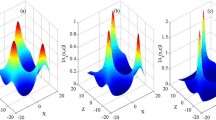Abstract
The Fokker-Planck equation is numerically solved to study the electron velocity distribution under steady heat conduction with an applied axial electric current in a model coronal loop.
If the loop temperature is so high that the electron mean-free path is longer than the local temperature scale height along the loop, a velocity hump appears at about the local thermal electron velocity. The hump is attributed to cooler electrons moving up the temperature gradient to compensate for the runaway electrons moving down the gradient. If the ratio between the mean free path and temperature scale height is greater than about 2, negative absorption for the plasma waves can appear (waves grow). This effect is enhanced by the presence of axial electric current in the half of the coronal loop in which the electrons carrying the current are drifting up the temperature gradient. Thus, the plasma instability may occur in the coronal elementary magnetic flux tubes. Although the present paper is limited to show the critical condition and linear growth rate of the instability, the following scenarios may be inferred.
If the flux tubes change from marginally stable to unstable against the plasma instability, due to an increase in the loop temperature, anomalous resistivity may suddenly appear because of the growth of plasma waves. Then a high axial electric field is induced that may accelerate particles. This could be the onset of impulsive loop flares.
For a low electric current, if the loop temperature is sufficiently high to give the negative absorption for the plasma waves in a large part of the coronal loop, steady plasma turbulence may originate. This could be a source for the type I radio noise storm.
Similar content being viewed by others
References
Hamberger, S. M. and Friedman, M.: 1968, Phys. Rev. Letters 21, 674.
Karpen, J. T. and Boris, J. P.: 1986, Astrophys. J. 307, 826.
Kennard, E. H.: 1938, Kinetic Theory of Gases, McGraw-Hill, New York, pp. 165–177.
Ljepojevic, N. N. and MacNeice, P.: 1988, Solar Phys. 117, 123.
Melrose, D. B.: 1980a, Plasma Astrophysics II, Gordon and Breach, New York, p. 132.
Melrose, D. B.: 1980b, Plasma Astrophysics II, Gordon and Breach, New York, p. 143.
Mikic, Z., Schnack, D. D., and Van Hoven, G.: 1989, Astrophys. J. 338, 1148.
Rosner, R., Tucker, W. H., and Vaiana, G. S.: 1978, Astrophys. J. 220, 643.
Roussel-Dupre, R.: 1980, Solar Phys. 68, 243.
Shoub, E. C.: 1983, Astrophys. J. 266, 339.
Smith, D. F.: 1986, Astrophys. J. 302, 836.
Takakura, T.: 1984, Solar Phys. 91, 311.
Takakura, T.: 1986, Solar Phys. 104, 363.
Takakura, T.: 1987a, Solar Phys. 107, 283.
Takakura, T.: 1987b, Solar Phys. 113, 221.
Takakura, T.: 1988, Solar Phys. 115, 149.
Trubnikov, B. A.: 1965, Reviews of Plasma Physics 1, Consultants Bureau, New York, p. 105.
Author information
Authors and Affiliations
Rights and permissions
About this article
Cite this article
Takakura, T. Steady heat conduction in coronal loop unstable against plasma instability. Sol Phys 127, 95–107 (1990). https://doi.org/10.1007/BF00158515
Received:
Revised:
Issue Date:
DOI: https://doi.org/10.1007/BF00158515




